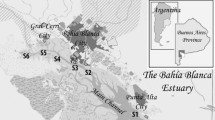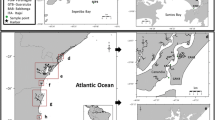Abstract
The study reports the first assessment for the quantification and speciation of butyltins (BTs) in surface marine sediment samples (0–5 cm) from intertidal mudflats of Sundarban mangrove wetland along with the Hugli (Ganges) river basin, eastern coastal part of India. Concentrations of tributyltin (TBT), dibutyltin (DBT) and monobutyltin (MBT) were monitored at 16 stations and present at all study areas, in concentrations in sediments up to 84.2, 26.4 and 48.0 ng g−1 of TBT, DBT and MBT, respectively. Significant correlations were obtained between MBT and DBT (r = 0.62, p = 0.01) and DBT and TBT (r = 0.54, p = 0.03). Calculated BT degradation index (BDI) values indicated recent contamination of BTs at 8 stations, and suggested either no degradation of TBT or very recent degradation at a 4 further stations. Additionally, BDI values also indicated no recent inputs of BTs in 4 stations (only MBT present in one of these stations). High concentrations of BTs, particularly TBT, have the potential to induce ecotoxicological impacts based on levels specified in Australian Sediment Quality Guidelines (SQGs). This study indicated that the majority of the analyzed stations were in the highest range of priority, due to high TBT concentrations.

Similar content being viewed by others
References
Alzieu C, Michel P, Tolosa I, Bacci E, Mee LD, Readman JW (1991) Organotin compounds in Mediterranean: a continuing cause for concern. Mar Environ Res 32:261–270
Antizar-Ladislao B (2008) Environmental levels, toxicity and human exposure to tributyltin (TBT)-contaminated marine environment: a review. Environ Int 34:292–308
Antizar-Ladislao B (2009) Polycyclic aromatic hydrocarbons, polychlorinated biphenyls, phthalates and organotins in northern Atlantic Spain’s coastal marine sediments. J Environ Monit 11:85–91
ANZECC/ARMCANZ (2000) Australian and New Zealand guidelines for fresh and marine water quality. Australian and New Zealand Environment and Conservation Council/Agriculture and Resource Management Council of Australia and New Zealand, Canberra
Beaumont AR, Newman PB (1986) Low levels of tributyltin reduce growth of marine micro-algae. Mar Pollut Bull 17:457–461
Berg M, Arnold DG, Muller SR, Muhlemann J, Schwarzenbach RP (2001) Sorption and desorption behaviour of organotin compounds in sediment-pore water systems. Environ Sci Technol 35:3151–3157
Burton ED, Phillips IR, Hawker DW (2004) Sorption and desorption behaviour of tributyltin with natural sediments. Environ Sci Technol 38:6694–6700
Burton ED, Phillips IR, Hawker DW (2006) Tributyltin partitioning in sediments: effects of aging. Chemosphere 63:73–81
Canuel EA, Martens CS (1993) Seasonal variations in the sources and alteration of organic matter associated with recently-deposited sediments. Org Geochem 20:563–577
CD Commission Directive (2002) 2002/62/EC of 9 July 2002. J Eur Community L183:58–59
Chatterjee M, Silva Filho EV, Sarkar SK, Sella SM, Bhattacharya A, Satpathy KK, Prasad MVR, Chakraborty S, Bhattacharya BD (2007) Distribution and possible source of trace elements in the sediment cores of a tropical macrotidal estuary and their ecotoxicological significance. Environ Int 33:346–356
Chiavarini S, Massanisso P, Nicolai P, Nobili C, Morabito R (2003) Butyltins concentration levels and imposex occurrence in snails from the Sicilian coast (Italy). Chemosphere 50:311–319
Diez S, Abalos M, Bayona JM (2002) Organotin contamination in sediments from the western Mediterranean enclosures following 10 years of TBT regulation. Water Res 36:905–918
DIONEX (2001) Application note 339, determination of organotin compounds in sediments using accelerated solvent extraction (ASE® DIONEX. http://www.dionex.com/en-us/webdocs/4489-AN339-ASE-Organotin-Sediments-08Apr2011-LPN1184-02.pdf. Accessed 1 July 2011
Fent K (1996) Eocotoxicology of organotin compounds. Crit Rev Toxicol 26:3–117
Folk RL, Ward WC (1957) Brazos River bar [Texas]; a study in the significance of grain size parameters. J Sediment Res 27:3–26
Garg A, Bhosle NB (2005) Butyltin compounds in the oyster, Saccostrea cucculata, from the West Coast of India. Bull Environ Contam Toxicol 75:982–988
Garg A, Anton-Martín R, García-Luque E, Riba I, DelValls TA (2009) Distribution of butyltins (TBT, DBT, MBT) in sediments of Gulf of Cádiz (Spain) and its bioaccumulation in the clam Ruditapes philippinarum. Ecotoxicology 18:1029–1035
Goldberg ED (1986) TBT: an environmental dilemma. Environ Int 28:17–44
Harino H, Ohji M, Wattayakorn G, Arai T, Rungsupa S, Miyazaki N (2006) Occurrence of antifouling biocides in sediment and green mussel from Thailand. Arch Environ Contam Toxicol 51:400–407
IMO, International Marine Organisation (2001) International convention on the control of harmful antifouling systems on ships. http://www.imo.org/Conventions/mainframe.asp?topic_id=529. Accessed 2 Apr 2007
Jadhav S, Bhosle NB, Massanisso P, Morabito R (2009) Organotins in the sediments of the Zuari estuary, west coast of India. J Environ Manag 90:S4–S7
Krumbein WC, Pettijohn FJ (1938) Manual of sedimentary petrology. Appleton Century Crofts, New York, p 549
Lagadic L, Coutellec MA, Caquet T (2007) Endocrine disruption in aquatic pulmonate molluscs: few evidences, many challenges. Ecotoxicology 16:45–59
Langston WJ, Pope ND (1995) Determinants of TBT adsorption and desorption in estuarine sediments. Mar Pollut Bull 31:32–43
Liao JF (1990) The chemical properties of the mangrove Solonchak in the northeast part of Hainan Island. Acta Sci Nat Univ Sunyat 9:67–72
Meador JP, Rice CA (2001) Impaired growth in the polychaete Armandia brevis exposed to tributyltin in sediment. Mar Environ Res 51:113–129
Meador JP, Collier TK, Stein JE (2002) Determination of a tissue and sediment threshold for tributyltin to protect prey species of juvenile salmonoids listed under the US Endangered Species Act. Aquat Conserv: Mar Freshw Ecosyst 12:539–551
Meena RM, Garg A, Jadhav S (2009) Seasonal variation in organotins in the waters of the Dona Paula Bay, west coast of India. Bull Environ Contam Toxicol 82:586–589
Mukherjee A, Rao KVM, Ramesh US (2009) Predicted concentrations of biocides from antifouling paints in Visakhapatnam Harbour. J Environ Manag 90:S51–S59
Nakanishi T (2008) Endocrine disruption induced by organotin compounds; organotins function as a powerful agonist for nuclear receptors rather than an aromatase inhibitor. J Toxicol Sci 33:269–276
Oehlmann J, Di Benedetto P, Tilmann M, Duft M, Oetken M, Schulte-Oehlmann U (2007) Endocrine disruption in prosobranch molluscs: evidence and ecological relevance. Ecotoxicology 16:29–43
Salazar MH, Salazar SM (1991) Assessing site-specific effects of TBT contamination with mussel growth rates. Mar Environ Res 32:131–150
Sarkar SK, Franciscovic-Bilinski S, Bhattacharya A, Saha M, Bilinski H (2004) Levels of elements in the surficial estuarine sediments of the Hugli River, northeast India and their environmental implications. Environ Int 30:1089–1098
Sonak S, Pangam P, Giriyan A, Hawaldar K (2009) Implications of the ban on organotins for protection of global coastal and marine ecology. J Environ Manag 90:S96–S108
StatSoft, Inc. (2011) Electronic statistics textbook. StatSoft, Tulsa. http://www.statsoft.com/textbook/. Printed version: Hill T, Lewicki P (2007) STATISTICS methods and applications. StatSoft, Tulsa
Stronkhorst J, Ciarelli S, Schipper CA, Postma JF, Dubbeldam M, Vangheluwe M, Brils JM, Hooftman R (2004) Inter-laboratory comparison of five marine bioassays for evaluating the toxicity of dredged material. Aquat Ecosyst Health Manag 7:147–159
Sumpter JP (2005) Endocrine disrupters in the aquatic environment: an overview. Acta Hydrochim Hydrobiol 33:9–16
Waite ME, Waldock MJ, Thain JE, Smith DJ, Milton SM (1991) Reductions in TBT concentrations in UK estuaries following legislation in 1986 and 1987. Mar Environ Res 32:89–111
Walkey A, Black TA (1934) An estimation Degitijaraff method for determining soil organic matter and proposed modification of the chromic acid titration method. Soil Sci 37:23–38
Acknowledgments
Antizar-Ladislao acknowledges the support from the Scottish Funding Council for the Joint Research Institute with the Heriot-Watt University, which is a part of the Edinburgh Research Partnership in Engineering and Mathematics (ERPem). Chatterjee and Bhattacharya are grateful to Council of Scientific and Industrial Research (CSIR), New Delhi, India for providing financial support.
Author information
Authors and Affiliations
Corresponding authors
Rights and permissions
About this article
Cite this article
Antizar-Ladislao, B., Sarkar, S.K., Anderson, P. et al. Baseline of butyltin contamination in sediments of Sundarban mangrove wetland and adjacent coastal regions, India. Ecotoxicology 20, 1975–1983 (2011). https://doi.org/10.1007/s10646-011-0739-5
Accepted:
Published:
Issue Date:
DOI: https://doi.org/10.1007/s10646-011-0739-5




